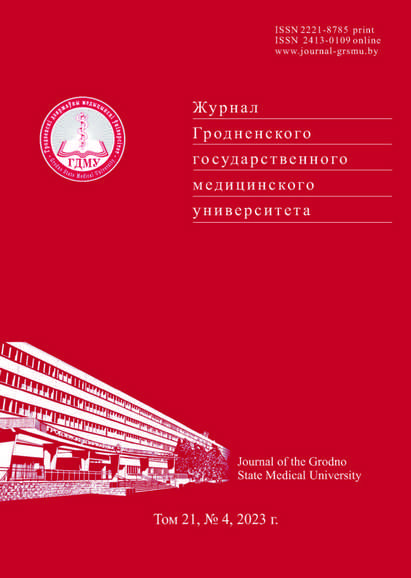КАТЕТЕР-АССОЦИИРОВАННЫЕ ИНФЕКЦИИ КРОВОТОКА В ИНТЕНСИВНОЙ ТЕРАПИИ – СОВРЕМЕННОЕ СОСТОЯНИЕ ПРОБЛЕМЫ

Аннотация
Эффективное лечение пациентов отделения интенсивной терапии тесно связано с необходимостью формирования временного или постоянного сосудистого доступа для проведения заместительной почечной терапии, инфузионно-трансфузионной терапии и мониторинга состояния пациента. Используемые для этого устройства – внутрисосудистые катетеры – представляют возможную угрозу для пациента, поскольку создают вероятность доступа микроорганизмов в системный кровоток, успешно нивелируя естественные механизмы защиты. В обзоре рассмотрены значимые факторы и патогенетические механизмы, приводящие к реализации инфекционного потенциала при наличии сосудистого катетера в кровотоке – катетер-ассоциированной инфекции, а также возможности диагностики, подходы к патогенетически обоснованной терапии и комплексной профилактике с позиции достижений современной медицинской науки и практики.
Литература
McManus BA, Coleman DC, Deasy EC, Brennan GI, O’Connell B, Monecke S, Ehricht R, Leggett B, Leonard N, Shore AC. Comparative genotypes, staphylococcal cassette chromosome mec (SCCmec) genes and antimicrobial resistance amongst Staphylococcus epidermidis and Staphylococcus haemolyticus isolates from infections in humans and companion animals. PloS One. 2015;10(9):e0138079. https://doi.org/10.1371/journal.pone.0138079.
Briko NI, Bikkulova DSh, Brusina EB, Ershova ON, Zhivotneva IV, Zabolotskij DV, Ivanova OA, Kvashnina DV, Kovalishena OV, Kuzkov VV, Kulabuhov VV, Pivkina AI, Suranova TG. Profilaktika kateter-associirovannyh infekcij krovotoka i uhod za centralnym venoznym kateterom (CVK). Nizhny Novgorod: Izdatelstvo “Remedium-Privolzhe”; 2017. 44 p. EDN: XPANCP. (Russian).
Kargaltseva NM, Borisova OYu, Kocherovets VI, Mironov AYu. Modern view on bloodstream infection in therapeutic patients. Practical Medicine. 2022;20(3):88-93. https://doi.org/10.32000/2072-1757-2022-3-88-93. https://elibrary.ru/jgukvu. (Russian).
Nordqvist H, Nilsson LE, Claesson C. Mutant prevention concentration of colistin alone and in combination with rifampicin for multidrug-resistant Acinetobacter baumannii. Eur J Clin Microbiol Infect Dis. 2016;35(11):1845-1850. https://doi.org/10.1007/s10096-016-2736-3.
Belsky DV, Rudnov VA, Belkin AA, Cherkasov GV, Yazov OA, Shchegolev AV, Pichugin AI, Boltayev PG, Semenkova GV. Spread of nosocomial infections in the neurosurgical intensive care units of Russia’s hospitals. Messenger of anesthesiology and resuscitation. 2011;8(4):22-29. edn: OKBTUP. (Russian).
Royo-Cebrecos C, Gudiol C, Ardanuy C, Pomares H, Calvo M, Carratalà J. A fresh look at polymicrobial bloodstream infection in cancer patients. PloS One. 2017;12(10):e0185768. https://doi.org/10.1371/journal.pone.0185768.
Chebotkevich VN, Bessmeltsev SS, Kiseleva EE, Stizhak NP, Kaitandzhan EI, Burylev VV. Clinical and microbiological characteristics of bloodstream infections in oncohematological patients. Oncohematology. 2016;11(3):58-67. https://doi.org/10.17650/1818-8346-2016-11-3-58-67. https://elibrary.ru/wmxbid. (Russian).
Kvashnina DV, Kovalishena OV, Belyanina NA. Comprehensive clinical and etiological, as well as epidemiological characteristics of the catheter-associated blood circulation infections. Medical Almanac. 2017 (4(49)):41-45. edn: ZIZZHJ. (Russian).
Zhang J, Wang B, Wang J, Yang Q. Ethanol locks for the prevention of catheter-related infection in patients with central venous catheter: a systematic review and meta-analysis of randomized controlled trials. PLoS One. 2019;14(9):e0222408. https://doi.org/10.1371/journal.pone.0222408.
Mart’yanov SV, Botchkova EA, Plakunov VK, Gannesen AV. The impact of norepinephrine on mono-species and dual-species staphylococcal biofilms. Microorganisms. 2021;9(4):820. https://doi.org/10.3390/microorganisms9040820.
McNamara JF, Righi E, Wright H, Hartel GF, Harris PN, Paterson DL. Long-term morbidity and mortality following bloodstream infection: a systematic literature review. J Infect. 2018;77(1):1-8. https://doi.org/10.1016/j.jinf.2018.03.005.
Goller CC, Romeo T. Environmental influences on biofilm development. Curr Top Microbiol Immunol. 2008;322:37-66. https://doi.org/10.1007/978-3-540-75418-3_3.
Crnich CJ, Halfmann JA, Crone WC, Maki DG. The effects of prolonged ethanol exposure on the mechanical properties of polyurethane and silicone catheters used for intravascular access. Infect Control Hosp Epidemiol. 2005;26(8):708-714. https://doi.org/10.1086/502607.
Boronina LG, Samatova EV. Application of laser light scattering technology for the diagnosis of catheter associated infections. Russian Clinical Laboratory Diagnostics. 2019;64(8):503-506. https://doi.org/10.18821/0869-2084-2019-64-8-503-506. https://elibrary.ru/znedxr. (Russian).
Walsh TJ, Rex JH. All catheter-related candidemia is not the same: assessment of the balance between the risks and benefits of removal of vascular catheters. Clin Infect Dis. 2002;34(5):600-602. https://doi.org/10.1086/338715.
Pratt RJ, Pellowe CM, Wilson JA, Loveday HP, Harper PJ, Jones S, McDougall C, Wilcox MH. epic2: National evidence-based guidelines for preventing healthcare-associated infections in NHS hospitals in England. J Hosp Infect. 2007;65:S1-S64. https://doi.org/10.1016/S0195-6701(07)60002-4.
Maki DG, Kluger DM, Crnich CJ. The risk of bloodstream infection in adults with different intravascular devices: a systematic review of 200 published prospective studies. Mayo Clin Proc. 2006;81(9):1159-1171. https://doi.org/10.4065/81.9.1159.
Lynch AS, Robertson GT. Bacterial and fungal biofilm infections. Annu Rev Med. 2008;59:415-428. https://doi.org/10.1146/annurev.med.59.110106.132000.
Hoffmann N, Lee B, Hentzer M, Rasmussen TB, Song Z, Johansen HK, Givskov M, Høiby N. Azithromycin blocks quorum sensing and alginate polymer formation and increases the sensitivity to serum and stationary-growth-phase killing of Pseudomonas aeruginosa and attenuates chronic P. aeruginosa lung infection in Cftr-/-mice. Antimicrob Agents Chemother. 2007;51(10):3677-3687. https://doi.org/10.1128/AAC.01011-06.
Gabrielyan NI, Gorskaya EM, Romanova NI, Tsirulnikova OM. Nosocomial infection and microbial biofilms in surgery. Russian journal of transplantology and artificial organs. 2012;14(3):83-91. edn: PCQACJ. (Russian).
Plakunov VK, Mart’yanov SV, Teteneva NA, Zhurina MV. Controlling of Microbial Biofilms Formation: Antiand Probiofilm Agents. Microbiology. 2017;86(4):402–420. https://doi.org/10.7868/S0026365617040127. https://elibrary.ru/zcrsrp. (Russian).
Mavrovounis G, Mermiri M, Chatzis DG, Pantazopoulos I. Peripherally Inserted Central Catheter lines for Intensive Care Unit and onco-hematologic patients: A systematic review and meta-analysis. Heart Lung. 2020;49(6):922-933. https://doi.org/10.1016/j.hrtlng.2020.07.008.
Brackman G, Coenye T. Quorum sensing inhibitors as anti-biofilm agents. Curr Pharm Des. 2015;21(1):5-11. https://doi.org/10.2174/1381612820666140905114627.
Lazãr V, Chifiriuc MC. Architecture and physiology of microbial biofilms. Roum Arch Microbiol Immunol. 2010;69(2):95-107.
Lubasovskaya LA, Kornienko MA, Priputnevich TV, Ilyina EN, Shchegolev AI. Microbiological and molecular genetic characteristics of coagulase-negative staphylococcal isolates from neonates in intensive care unit. Antibiotics and Chemotherapy. 2013;58(3-4):25-32. edn: SXWTLB. (Russian).
Mielke N, Johnson S, Karabon P, Bahl A. A prospective sonographic evaluation of peripheral intravenous catheter associated thrombophlebitis. J Vasc Access. 2022;23(5):754-763. https://doi.org/10.1177/11297298211009019.
Denisuik AJ, Lagacé-Wiens PR, Pitout JD, Mulvey MR, Simner PJ, Tailor F, Karlowsky JA, Hoban DJ, Adam HJ, Zhanel GG. Molecular epidemiology of extended-spectrum β-lactamase-, AmpC β-lactamase-and carbapenemase-producing Escherichia coli and Klebsiella pneumoniae isolated from Canadian hospitals over a 5 year period: CANWARD 2007-11. J Antimicrob Chemother. 2013;68(Suppl 1):i57-i65. https://doi.org/10.1093/jac/dkt027.
Vallés J, Ferrer R. Bloodstream infection in the ICU. Infect Dis Clin North Am. 2009;23(3):557-569. https://doi.org/10.1016/j.idc.2009.04.005.
Hentzer M, Teitzel GM, Balzer GJ, Heydorn A, Molin S, Givskov M, Parsek MR. Alginate overproduction affects Pseudomonas aeruginosa biofilm structure and function. J Bacteriol. 2001;183(18):5395-5401. https://doi.org/10.1128/JB.183.18.5395-5401.2001.
Shirokova IJu, Belyanina NA, Kvashnina DV, Kovalishena OV. Characteristics of the sensitivity of hospital strains of microorganisms to local antimicrobials. Medical Almanac. 2020;(3(64)):57-63. edn: BTRLFM. (Russian).
Curtin JJ, Donlan RM. Using bacteriophages to reduce formation of catheter-associated biofilms by Staphylococcus epidermidis. Antimicrob Agents Chemother. 2006;50(4):1268-1275. https://doi.org/10.1128/AAC.50.4.1268-1275.2006.
Lauderdale KJ, Boles BR, Cheung AL, Horswill AR. Interconnections between Sigma B, agr, and proteolytic activity in Staphylococcus aureus biofilm maturation.Infect Immun. 2009;77(4):1623-1635. https://doi.org/10.1128/IAI.01036-08.
Chebotar IV. Mechanisms of antibiofilm immunity. Annals of the Russian Academy of Medical Sciences. 2012;67(12):22-29. https://doi.org/10.15690/vramn.v67i12.477. https://elibrary.ru/pmqgjb. (Russian).
Kaplan JB, LoVetri K, Cardona ST, Madhyastha S, Sadovskaya I, Jabbouri S, Izano EA. Recombinant human DNase I decreases biofilm and increases antimicrobial susceptibility in staphylococci. J Antibiot. 2012;65(2):73-77. https://doi.org/10.1038/ja.2011.113.
Norris LB, Kablaoui F, Brilhart MK, Bookstaver PB. Systematic review of antimicrobial lock therapy for prevention of central-line-associated bloodstream infections in adult and pediatric cancer patients. Int J Antimicrob Agents. 2017;50(3):308-317. https://doi.org/10.1016/j.ijantimicag.2017.06.013.
Forauer AR, Theoharis CG, Dasika NL. Jugular vein catheter placement: histologic features and development of catheter-related (fibrin) sheaths in a swine model. Radiology. 2006;240(2):427-434. https://doi.org/10.1148/radiol.2402031129.
Muñoz P, Bouza E, San Juan R, Voss A, Pascau J, Desco M. Infections (ESGNI) C operative G of the ESG on N. Clinical-epidemiological characteristics and outcome of patients with catheter-related bloodstream infections in Europe (ESGNI-006 Study). Clin Microbiol Infect. 2004;10(9):843-845. https://doi.org/10.1111/j.1469-0691.2004.00955.x.
Gallieni M, Pittiruti M, Biffi R. Vascular access in oncology patients. CA Cancer J Clin. 2008;58(6):323-346. https://doi.org/10.3322/CA.2008.0015.
Gorski LA, Hadaway L, Hagle ME, Broadhurst D, Clare S, Kleidon T, Meyer BM, Nickel B, Rowley S, Sharpe E. Infusion therapy standards of practice. J Infus Nurs. 2021;44(1S Suppl 1):S1-S224. https://doi.org/10.1097/NAN.0000000000000396.
O’Grady NP, Alexander M, Burns LA, Dellinger EP, Garland J, Heard SO, Lipsett PA, Masur H, Mermel LA, Pearson ML, Raad II, Randolph AG, Rupp ME, Saint S. Guidelines for the prevention of intravascular catheter-related infections. Clin Infect Dis. 2011;52(9):e162–e193. https://doi.org/10.1093/cid/cir257.
Boucley I, Dargent A, Andreu P, Roudaut JB, Aptel F, Labruyère M, Jacquier M, Cransac A, Quenot JP. Systematic review of locking solutions for non-tunneled hemodialysis catheters. Hemodial Int. 2023;27(1):12–20. https://doi.org/10.1111/hdi.13047.
Souweine B, Lautrette A, Gruson D, Canet E, Klouche K, Argaud L, Bohe J, Garrouste-Orgeas M, Mariat C, Vincent F, Cayot S, Cointault O, Lepape A, Guelon D, Darmon M, Vesin A, Caillot N, Schwebel C, Boyer A, Azoulay E, Bouadma L, Timsit JF. Ethanol lock and risk of hemodialysis catheter infection in critically ill patients. A randomized controlled trial. Am J Respir Crit Care Med. 2015;191(9):1024-1032. https://doi.org/10.1164/rccm.201408-1431OC.
Del Pozo JL. Novel treatment dynamics for biofilm-related infections. Expert Rev Anti Infect Ther. 2021;19(11):1443-1456. https://doi.org/10.1080/14787210.2021.1917993.
Pammi M, Liang R, Hicks J, Mistretta TA, Versalovic J. Biofilm extracellular DNA enhances mixed species biofilms of Staphylococcus epidermidis and Candida albicans. BMC Microbiol. 2013;13:257. https://doi.org/10.1186/1471-2180-13-257.
Timsit JF, Mimoz O, Mourvillier B, Souweine B, Garrouste-Orgeas M, Alfandari S, Plantefeve G, Bronchard R, Troche G, Gauzit R, Antona M, Canet E, Bohe J, Lepape A, Vesin A, Arrault X, Schwebel C, Adrie C, Zahar JR, Ruckly S, Tournegros C, Lucet JC. Randomized controlled trial of chlorhexidine dressing and highly adhesive dressing for preventing catheter-related infections in critically ill adults. Am J Respir Crit Care Med. 2012;186(12):1272-1278. https://doi.org/10.1164/rccm.201206-1038OC.
Sheng KX, Zhang P, Li JW, Cheng J, He YC, Böhlke M, Chen JH. Comparative efficacy and safety of lock solutions for the prevention of catheter-related complications including infectious and bleeding events in adult haemodialysis patients: a systematic review and network meta-analysis. Clin Microbiol Infect. 2020;26(5):545-552. https://doi.org/10.1016/j.cmi.2019.12.003.




























